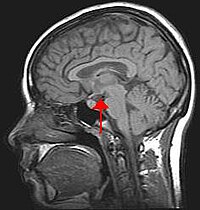
Photo from wikipedia
Matrix effects are a great challenge for the quantitative analysis of complex food samples by liquid chromatography-tandem mass spectrometry analysis (LC-MS/MS). Stable isotope labeling (SIL) has been widely used as… Click to show full abstract
Matrix effects are a great challenge for the quantitative analysis of complex food samples by liquid chromatography-tandem mass spectrometry analysis (LC-MS/MS). Stable isotope labeling (SIL) has been widely used as an effective strategy to eliminate matrix effects. Herein, a copper(I)-catalyzed azide-alkyne cycloaddition (CuAAC) click-reaction-based SIL method was proposed for a highly sensitive and selective determination of six synthetic steroid hormones in three different food samples (milk, yogurt, and eggs) by high-performance liquid chromatography (HPLC)-MS/MS. A pair of novel SIL agents, N-(2-azidyl ethyl) aniline (d0-AEA) and d5-N-(2-azidyl ethyl) aniline (d5-AEA) were synthesized to label steroid hormones in the samples and standard solution, respectively. The reaction accomplishes in 30 min at 60 °C. The heavy labeled standards were used as internal standards (ISs), which experience the identical ionization processes with light labeled samples to minimize matrix effects. After derivatization, the ionization efficiencies of steroid hormones were greatly improved by 2-54-folds, and the matrix effects ranged from 88.6 to 99.8%. The established method achieved satisfactory detection limits (0.1-2.5 μg L-1) and high recoveries (85-102%). These results demonstrated that the proposed method holds unique advantages for trace steroid hormones analysis in foodstuffs.
Journal Title: Journal of agricultural and food chemistry
Year Published: 2022
Link to full text (if available)
Share on Social Media: Sign Up to like & get
recommendations!